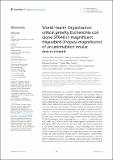Por favor, use este identificador para citar o enlazar a este item:
http://hdl.handle.net/10261/305132COMPARTIR / EXPORTAR:
 SHARE SHARE
 CORE
BASE CORE
BASE
|
|
| Visualizar otros formatos: MARC | Dublin Core | RDF | ORE | MODS | METS | DIDL | DATACITE | |

| Título: | World Health Organization critical priority Escherichia coli clone ST648 in magnificent frigatebird (Fregata magnificens) of an uninhabited insular environment |
Autor: | Ewbank, Ana Carolina; Fuentes-Castillo, D.; Sacristán, Carlos CSIC ORCID ; Esposito, Fernanda; Fuga, B.; Cardoso, Brenda; Godoy, S.N.; Zamana-Ramblas, Roberta; Gattamorta, M.A.; Catão-Dias, J. L.; Lincopan, N. | Palabras clave: | pAmpC ESBL Antimicrobial resistance Island, wildlife One Health |
Fecha de publicación: | 11-ago-2022 | Editor: | Frontiers Media | Citación: | Frontiers in Microbiology 13; e940600 (2022) | Resumen: | Antimicrobial resistance is an ancient natural phenomenon increasingly pressured by anthropogenic activities. Escherichia coli has been used as markers of environmental contamination and human-related activity. Seabirds may be bioindicators of clinically relevant bacterial pathogens and their antimicrobial resistance genes, including extended-spectrum-beta-lactamase (ESBL) and/or plasmid-encoded AmpC (pAmpC), in anthropized and remote areas. We evaluated cloacal swabs of 20 wild magnificent frigatebirds (Fregata magnificens) of the Alcatrazes Archipelago, the biggest breeding colony of magnificent frigatebirds in the southern Atlantic and a natural protected area with no history of human occupation, located in the anthropized southeastern Brazilian coast. We characterized a highly virulent multidrug-resistant ST648 (O153:H9) pandemic clone, harboring bla, bla, qnrB, tetB, sul1, sul2, aadA1, aac(3)-VIa and mdfA, and virulence genes characteristic of avian pathogenic (APEC) (hlyF, iroN, iss, iutA, and ompT) and other extraintestinal E. coli (ExPEC) (chuA, kpsMII, and papC). To our knowledge, this is the first report of ST648 E. coli co-producing ESBL and pAmpC in wild birds inhabiting insular environments. We suggest this potentially zoonotic and pathogenic lineage was likely acquired through indirect anthropogenic contamination of the marine environment, ingestion of contaminated seafood, or by intra and/or interspecific contact. Our findings reinforce the role of wild birds as anthropization sentinels in insular environments and the importance of wildlife surveillance studies on pathogens of critical priority classified by the World Health Organization. | Descripción: | 10 Pág. | Versión del editor: | http://dx.doi.org/10.3389/fmicb.2022.940600 | URI: | http://hdl.handle.net/10261/305132 | DOI: | 10.3389/fmicb.2022.940600 | ISSN: | 1664-302X | Identificadores: | doi: 10.3389/fmicb.2022.940600 issn: 1664-302X |
| Aparece en las colecciones: | (INIA) Artículos |
Ficheros en este ítem:
| Fichero | Descripción | Tamaño | Formato | |
|---|---|---|---|---|
| World_Health_Organization_critical_priority.pdf | 1,46 MB | Adobe PDF |  Visualizar/Abrir |
CORE Recommender
SCOPUSTM
Citations
7
checked on 15-may-2024
WEB OF SCIENCETM
Citations
6
checked on 23-feb-2024
Page view(s)
28
checked on 16-may-2024
Download(s)
29
checked on 16-may-2024
Google ScholarTM
Check
Altmetric
Altmetric
Este item está licenciado bajo una Licencia Creative Commons

